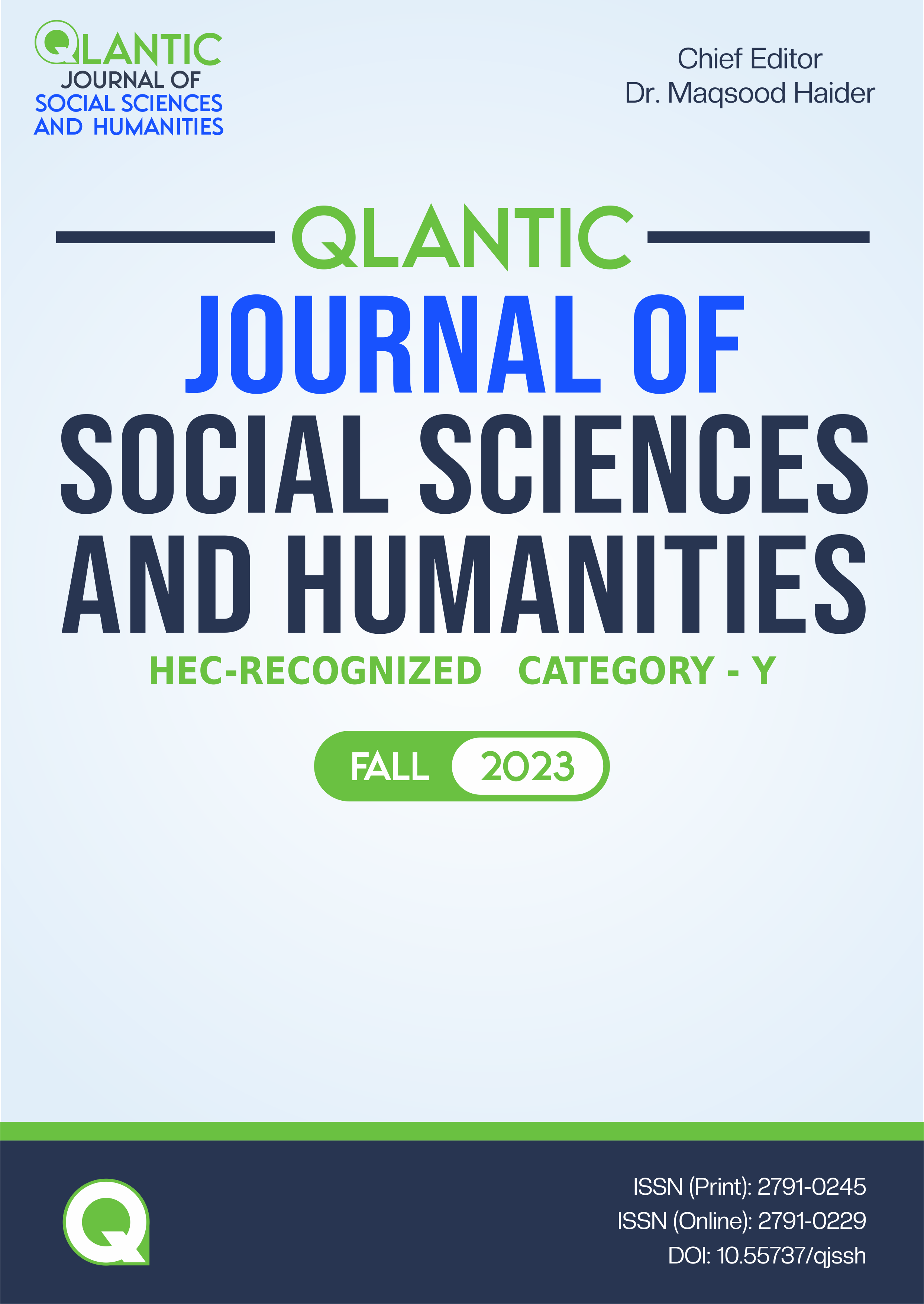A Study of Cohesive Devices in Students’ Academic Writing
DOI:
https://doi.org/10.55737/qjssh.897009451Keywords:
English as a Foreign Language, Academic Writing, StudentsAbstract
Writing is a challenging skill for learners learning English as a foreign language. When writing English, students face many problems triggered by a lack of knowledge of the English language, interference with their mother tongue, and difficulties related to vocabulary and grammar usage. One particular demanding aspect of writing is attaining coherence and text harmony. Literature indicates that many second language learners tend to underuse, misuse, or overuse cohesive devices, which is crucial in maintaining coherence and cohesion in academic writing. This research focused on evaluating the use of cohesive devices in the academic writing of undergraduates majoring in English at Islamia College Peshawar. Data were gathered through student-written essays on IELTS test topics, with 30 randomly selected samples from each of the 4th, 6th, and 8th semesters, totaling 90 samples. Employing both quantitative and qualitative methods, the analysis revealed a prevalent issue: the inaccurate utilization of various cohesive devices. Students demonstrated an understanding of structuring discussion texts coherently, yet their challenges stemmed from the misapplication of cohesive devices, leading to incomprehensible texts. This study explored lexical and grammatical cohesion, leading to the recommendation that future research should embrace aspects like sentence structure, tense usage, and alternative cohesive models.
References
Abusaeedi, R., & Asghar, A. (2012). Use of Cohesive Ties in English as a Foreign Language Students’ Writing. Iranian Journal of Applied Language Studies, 2(1), 137–156. https://doi.org/10.22111/ijals.2012.65
Adiantika, H. N. (2015). Cohesive devices in EFL students’ expository writing. English Review: Journal of English Education, 4(1), 94. https://doi.org/10.25134/erjee.v4i1.316
Al Fadda, H. (2012). Difficulties in Academic Writing: From the Perspective of King Saud University Postgraduate Students. English Language Teaching, 5(3). https://doi.org/10.5539/elt.v5n3p123
Alarcon, J. B., & Ninfa, K. (2011). Grammatical cohesion in students’ argumentative essay. International Journal of English and Literature, 2(5), 114–127. https://doi.org/10.5897/ijel.9000016
Ali, M. E. E. (2016). Using cohesive devices during the course of lectures “the lectures’ role”. International Research Journal of Social Sciences, 5(5), 33-36. https://www.isca.in/IJSS/Archive/v5/i5/8.ISCA-IRJSS-2016-055.pdf
Ary, D., Jacobs, L. C., Irvine, C. K. S., & Walker, D. (2018). Introduction to Research in Education. Cengage Learning
Bae, J. (2001). Cohesion and coherence in children's written English: Immersion and English-only classes. Issues in Applied Linguistics, 12(1). https://doi.org/10.5070/l4121005043
Bassey, M. (1999). Case study research in educational settings. In ci.nii.ac.jp. Open University Press. http://ci.nii.ac.jp/ncid/BA41300676
Braine, G., & Yorozu, M. (1998). Local Area Network (LAN) Computers in ESL and
EFL Writing Classes. JALT Journal, 20(2), 47-59. https://jalt-publications.org/sites/default/files/pdf-article/jj-20.2-art3.pdf
Brostoff, A. (1981). Coherence: "Next to" Is not "Connected to". College Composition and Communication, 32(3), 278-294. https://doi.org/10.2307/356191
Brown, D. H. (2003). Language Assessment - Principles and Classroom Practice (1st ed.). Pearson ESL.
Celce-Murcia, M., & Snow, M. A. (2014). Teaching English as a Second Or Foreign Language. Heinle ELT.
Chanyoo, N. (2013). A corpus-based study of connectors and thematic progression in the academic writing of Thai EFL students. Doctoral Dissertation. University of Pittsburgh, USA.
Dar, M. F., & Khan, I. (2015). Writing Anxiety Among Public And Private Sectors Pakistani Undergraduate University Students. Pakistan Journal of Gender Studies, 10(1), 157–172. https://doi.org/10.46568/pjgs.v10i1.232
Darweesh, A. D., & Kadhim, S. A. (2016). Iraqi EFL Learners' Problems in Using Conjunctions as Cohesive Devices. Journal of Education and Practice, 7(11), 169-180. https://files.eric.ed.gov/fulltext/EJ1099615.pdf
Dastjerdi, H. V., & Samian, S. H. (2011). Quality of Iranian EFL Learners’ Argumentative Essays: Cohesive Devices in Focus. Mediterranean Journal of Social Sciences, 2(2), 65. http://journaldatabase.info/download/pdf/quality_iranian_efl_learners
Denscombe, M. (2007) The Good Research Guide (4th de.) Open University Press, 2, 30-31.
Eggins, S. (1994). An Introduction to Systemic Functional Linguistics. London, England: Pinter Publisher
Gill, C. M. (2014). Essential Writing Skills for College and Beyond (Illustrated ed.). Writer’s Digest Books.
Haider, S. (2022). A Corpus-based Analysis of Coherent Writing Skills of Pakistani English Language Learners. Pakistan Languages and Humanities Review, 6(II). https://doi.org/10.47205/plhr.2022(6-ii)76
Halliday, M. A. K. (2004). An Introduction to Functional Grammar. Routledge. https://doi.org/10.4324/9780203783771
Halliday, M., & Hasan, R. (1976). Cohesion in English (English Language Series; No. 9) (1st ed.). Longman.
Harmer, J. (2007). The Practice of English Language Teaching with DVD (4th Edition) (Longman Handbooks for Language Teachers) (4th ed.). Pearson Longman ELT.
Holloway, D. W. (1981). Semantic grammars: How they can help us teach writing. College Composition and Communication, 32(2), 205-218. https://doi.org/10.2307/356694
Hyland, K. (2018). Metadiscourse: Exploring Interaction in Writing. Bloomsbury Publishing.
Irvin, L. L. (2010). What is academic writing? In C. Lowe and P. Zemliansky (Eds) Writing Spaces: Readings on Writing volume 1. Indiana: Parlor press. pp 3-17.
Johnson, P. J. (1992). Cohesion and Coherence in Compositions in Malay and English. RELC Journal, 23(2), 1–17. https://doi.org/10.1177/003368829202300201
Karadeniz, A. (2017). Cohesion and Coherence in Written Texts of Students of Faculty of Education. Journal of Education and Training Studies, 5(2), 93. https://doi.org/10.11114/jets.v5i2.1998
Karasi, M. (1994). Cohesive features in the expository essays of secondary four (express) and secondary five (normal) students in Singapore. Dr.ntu.edu.sg. https://dr.ntu.edu.sg/handle/10356/20300
Kellogg, R. T. (2001). Long-term working memory in text production. Memory & Cognition, 29(1), 43-52. https://doi.org/10.3758/bf03195739
Liu, M., & Braine, G. (2005). Cohesive features in argumentative writing produced by Chinese undergraduates. System, 33(4), 623–636. https://doi.org/10.1016/j.system.2005.02.002
Lodico, M. G., Spaulding, D. T., & Voegtle, K. H. (2010). Methods in educational research: From Theory to Practice. John Wiley & Sons.
Murray, R. (2005). Writing for Academic Journals (Study Skills) (1st ed.). Open University Press.
Namaziandost, E., Nasri, M., & Keshmirshekan, M. H. (2019). Cohesive Conjunctions in Applied Linguistics Research Articles among Iranian and Non-Iranian Researchers: A Comparative Corpus-based Study. Journal of English Language Studies, 4(2), 101. https://doi.org/10.30870/jels.v4i2.5431
Nunan, D. (1989). Designing tasks for the communicative classroom. Cambridge University Press, United Kingdom.
Nurwahidah, N., Hidayat, D. N., Husna, N., & Alek, A. (2022). A Discourse Analysis of Grammatical Cohesion in News Item Text of “Symphony 3” XII Grade English Textbook. Journal of English Language Teaching and Linguistics, 7(1), 171. https://doi.org/10.21462/jeltl.v7i1.764
Oshima, A., & Hogue, A. (2007). Introduction to Academic Writing, Second Edition (The Longman Academic Writing Series) (Subsequent). Longman Pub Group.
Richards, J. C. (1971). Error Analysis and Second Language Strategies. International Center for Research on Bilingualism.
Rose, H., McKinley, J., & Baffoe-Djan, J. B. (2019). Data collection Research methods in applied Linguistics. Bloomsbury Publishing.
Taboada, M. (2004). Building Coherence and Cohesion: Task-oriented dialogue in English and Spanish (Pragmatics & Beyond New Series) (Bilingual). John Benjamins Publishing Company.
Tajeddin, Z., & Rahimi, A. (2017). A Conversation Analysis of Ellipsis and Substitution in Global Business English Textbooks. International Journal of Society, Culture & Language, 5(1), 1-14. https://www.ijscl.net/article_23930_176e4ec9abb88cdfc198d5707c336741.pdf
Tanskanen, S. (2006). Collaborating towards Coherence: Lexical cohesion in English discourse (Pragmatics and Beyond New Series). John Benjamins Publishing Company.
Tusting, K., McCulloch, S., Bhatt, I., Hamilton, M., & Barton, D. (2019). Academics Writing: The Dynamics of Knowledge Creation (1st ed.). Routledge.
Xuefan, C. (2007). Lexical cohesion in Chinese college EFL writing. Celea Journal, 30(5), 46-57.
Yule, G. (2022). The Study of Language (8th ed.). Cambridge University Press.
Downloads
Published
Issue
Section
License
Copyright (c) 2023 Gohar Rahman, Muhammad Saqib Zaigham, Muhammad Umer

This work is licensed under a Creative Commons Attribution-NonCommercial 4.0 International License.





